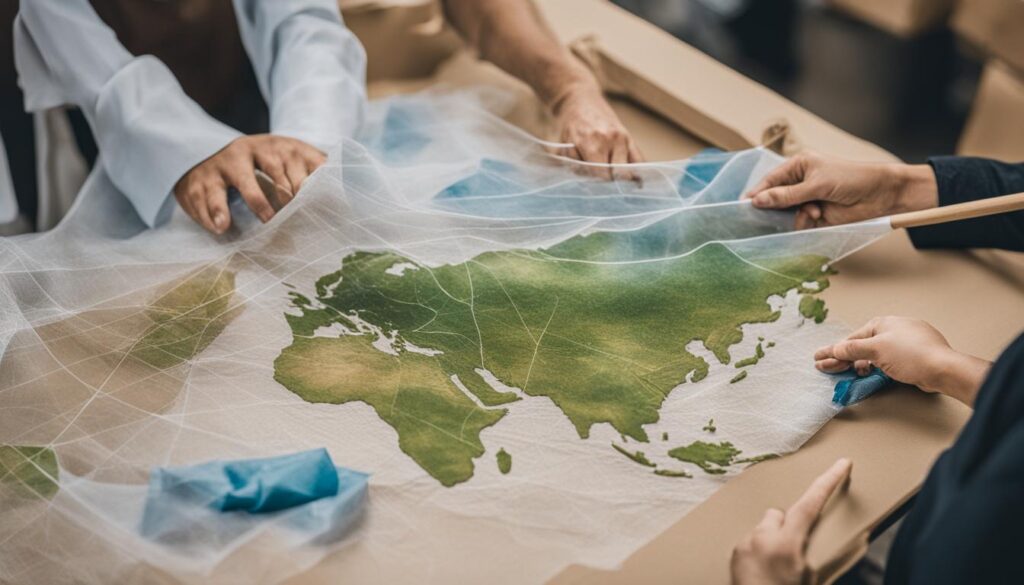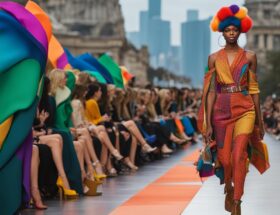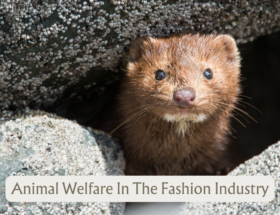In 2024, sustainable fashion will continue to evolve as consumer demand for transparency, eco-conscious choices, and ethical practices grows. With a focus on sustainability, fashion is entering a new era where style meets conscience. Let’s explore the key trends that will shape the fashion landscape in 2024 and discover how you can embrace the eco-chic look.
Quick and Easy Navigation
Key Takeaways:
- Transparency in the supply chain is crucial for sustainable fashion.
- Beware of greenwashing and support brands that prioritize sustainability.
- Exciting textile innovations are driving sustainable material choices.
- Rental options and upcycling offer sustainable alternatives to fast fashion.
- Adding AI and Technology in Fashion
Transparency and Supply Chain: Fashion Futures

The demand for sustainability in fashion has led to an increased focus on transparency and ethical practices in the supply chain. Today’s consumers are more aware and conscious of the environmental and social impact of the clothes they wear, and they expect brands to align with their values.
Transparency is the key to building trust and credibility in the fashion industry. Consumers are asking for brands to disclose information about their workers’ wages and working conditions, as well as their sourcing and production processes. They want to know where their clothes come from, who made them, and under what conditions.
The fashion revolution transparency index reveals that 99% of the brands reviewed do not disclose the percentage of workers in their supply chain earning a living wage. This lack of transparency is concerning and highlights the need for more accountability in the industry. Efforts are being made to scale fashion production while supporting the well-being of supply chain workers.
As the fashion industry moves towards a more sustainable future, brands need to be proactive in embracing transparency and making improvements where necessary. By providing clear and honest information about their supply chain, brands can empower consumers to make informed choices and support ethical fashion practices.
Transparency is not just a trend; it’s a necessity for the future of fashion. Brands that fail to prioritize transparency risk losing the trust and loyalty of their customers. It’s time for the fashion industry to step up, be accountable, and work towards a more sustainable and transparent future.
Greenwashing: The Danger of False Sustainability Claims
As sustainability becomes a buzzword in the fashion industry, there is a growing concern about greenwashing – the practice of falsely claiming to be sustainable.
Greenwashing is a deceptive tactic that misleads consumers into believing that a brand is prioritizing sustainability when, in reality, it may be far from the truth. This form of false advertising undermines the efforts of truly sustainable brands and creates confusion among consumers who genuinely want to make ethical choices.
“Greenwashing is like a mirage in the desert; it promises sustainability but delivers disappointment. It’s essential for consumers to educate themselves and look beyond the surface to identify genuine sustainable practices.” – Juliet
Recognizing greenwashing can be challenging, as brands often use vague or ambiguous terms without providing concrete evidence to support their claims. However, there are certain red flags to watch out for. If a brand heavily markets its eco-friendly initiatives without transparently disclosing its supply chain, sourcing practices, or manufacturing processes, it may be a sign of greenwashing. Additionally, if a brand’s sustainability claims seem too good to be true, it’s worth delving deeper to ensure authenticity.
As consumers, it is essential to support brands that prioritize sustainability and are genuinely committed to reducing their environmental impact. By doing thorough research, reading labels, and looking for certifications from reputable organizations, we can make informed choices and hold brands accountable for their actions. Together, we can combat greenwashing and create a more sustainable future for the fashion industry.
A Change of Material: Textiles Futures

When it comes to sustainable fashion, one of the key areas of focus is the material used in clothing production. In 2024, the fashion industry is set to witness a change of material with the emergence of innovative textile solutions that prioritize sustainability. These advancements aim to reduce the environmental impact of the fashion industry and promote more ethical and eco-friendly practices.
One of the notable developments is the introduction of lower-impact circular synthetic fills. These fills provide an alternative to traditional synthetic materials, which are often derived from non-renewable resources and contribute to pollution. By embracing this change, fashion brands can reduce their carbon footprint while still delivering quality and stylish products.
Moreover, there will be a shift towards certified ethical down and feathers, addressing concerns about animal welfare in the production of outerwear. With the use of responsibly sourced materials, brands can offer consumers a more sustainable and compassionate choice.
Table: Sustainable Materials Innovations
| Textile Innovation | Description |
|---|---|
| Lower-Impact Circular Synthetic Fills | Offers an alternative to traditional synthetic materials, reducing environmental impact and promoting sustainability. |
| Certified Ethical Down and Feathers | Addresses concerns about animal welfare by using responsibly sourced materials in outerwear production. |
| Animal Wool Alternatives | Introduces sustainable alternatives to animal-derived wool, reducing the industry’s reliance on animal farming. |
| Plant-Based Fiber Insulations | Utilizes fibers derived from plants like bamboo and hemp, providing a more sustainable insulation option. |
Additionally, the fashion industry is exploring animal wool alternatives and plant-based fiber insulations. By reducing the reliance on animal farming for wool production and embracing plant-based materials, brands can contribute to a more sustainable and cruelty-free future.
Overall, the change of material in the fashion industry brings exciting prospects for sustainable fashion. With innovations in textile technology, brands can embrace eco-friendly alternatives and make a positive impact on the environment without compromising on style and quality.
Rental Options Are Widening: Embracing Sustainable Fashion
As sustainable fashion continues to gain momentum, consumers are increasingly turning to rental options as a way to embrace eco-friendly fashion without compromising style or breaking the bank. The demand for rental fashion has surged in recent years, driven by the growing awareness of the environmental impact of fast fashion and the desire for more sustainable alternatives. Rental platforms have made it easier than ever to access a wide range of clothing and accessories, catering to various occasions and personal preferences.
By renting instead of buying, individuals can reduce their carbon footprint by minimizing the production and disposal of clothing. Renting allows fashion enthusiasts to experiment with different styles and trends without the guilt of contributing to textile waste. It also offers a cost-effective solution for special events like weddings or parties, where one-time wear outfits can be a significant expense.
With an array of rental options available, consumers can curate their wardrobe sustainably, choosing from a variety of high-quality, designer pieces that align with their values. From formal dresses to everyday essentials, rental platforms offer a diverse selection that caters to different sizes, styles, and occasions. By participating in the rental fashion movement, individuals can make a conscious choice to reduce their fashion footprint while still looking fabulous.
| Rental Benefits | Sustainable Fashion Impact |
|---|---|
| Cost-effective alternative to buying | Reduces textile waste |
| Access to high-quality, designer pieces | Minimizes carbon footprint |
| Allows for experimentation with different styles | Supports the circular economy |
| Convenient for one-time wear occasions | Encourages sustainable consumption |
Renting fashion is not only a practical and sustainable choice but also a way to support the growing sharing economy and contribute to the shift towards a more circular fashion industry. By embracing rental options, individuals can play a part in reducing the environmental impact of fashion and promoting a more conscious and eco-friendly lifestyle.

Sustainability in Fashion: Embracing Upcycling as a Sustainable Solution
The fashion industry is experiencing a shift towards more sustainable practices, and one of the key strategies gaining momentum is upcycling. Upcycling, the process of transforming waste materials into new products, offers a creative and eco-friendly solution to fashion waste. With a focus on repurposing and reimagining discarded materials, upcycling promotes a circular economy and reduces the environmental impact of the industry.
Brands like Doodlage, Rassleela, and Patch over Patch are leading the way in upcycled fashion, showcasing innovative designs that breathe new life into old clothes. Through their unique approaches to upcycling, these brands are challenging the traditional notion of fashion and proving that sustainable can also be stylish.
With upcycling clothes, consumers have the opportunity to support a more sustainable fashion industry by choosing garments made from recycled materials or upcycled fashion pieces. By embracing upcycling as a viable alternative to fast fashion, we can contribute to reducing waste and promoting a more conscious and eco-friendly approach to fashion consumption.

| Benefits of Upcycling in Fashion | Examples of Upcycled Fashion Brands |
|---|---|
| Reduces fashion waste Minimizes the need for new raw materials Promotes a circular economy Encourages creativity and individuality | Doodlage Rassleela The Second Life Patch over Patch |
The Economic and Environmental Impact of Upcycling
Upcycling not only offers environmental benefits but also has a positive economic impact. By utilizing existing materials, upcycling reduces the demand for new resources and lowers production costs. This, in turn, can lead to more affordable and accessible sustainable fashion options for consumers.
Furthermore, upcycling helps divert textiles from landfills and reduces the overall carbon footprint of the fashion industry. According to the Ellen MacArthur Foundation, if just 1% of the textiles currently sent to landfill were upcycled, it could save up to 6 million tons of CO2 emissions annually.
Embracing a Sustainable Future through Upcycling
As consumers, we have the power to drive change in the fashion industry. By choosing upcycled fashion and supporting brands that prioritize sustainable practices, we can contribute to a more sustainable and ethical fashion future. Upcycling not only offers a sustainable solution to fashion waste but also allows us to make a personal statement through unique and environmentally conscious style choices. Let’s embrace upcycling as a fundamental part of our fashion journey towards a greener and more sustainable future.
Achieving Climate Targets: The Role of Active Intelligence
Active intelligence encompasses various strategies and practices aimed at reducing carbon emissions and establishing a circular economy within the activewear industry. Brands are utilizing innovative materials, such as recycled polyester and organic cotton, to minimize their environmental footprint. These materials not only help reduce waste but also offer improved performance and durability.
Furthermore, companies are investing in research and development to create new fabric technologies that have a lower carbon footprint. This includes exploring the use of bio-based materials derived from renewable sources, like algae or seaweed. These bio-based fabrics have the potential to revolutionize the activewear industry by providing sustainable alternatives to traditional synthetic materials.
Designing for climate targets also involves rethinking the entire product life cycle. Brands are implementing take-back programs to encourage customers to return old or worn-out activewear for recycling or upcycling. By doing so, they not only minimize waste but also extend the lifespan of their products.
| Key Initiatives for Designing Climate-Friendly Activewear | Benefits |
|---|---|
| Utilizing recycled and organic materials | Reduces waste and minimizes environmental impact |
| Investing in research and development of bio-based materials | Provides sustainable alternatives to synthetic fabrics |
| Implementing take-back programs for recycling or upcycling | Minimizes waste and extends product lifespan |
The fashion industry is increasingly recognizing the importance of active intelligence in designing for climate targets. By embracing sustainable practices and prioritizing eco-friendly materials, brands can make a significant impact on reducing carbon emissions and preserving the planet for future generations.
Conclusion
In 2024, sustainable fashion trends will continue to shape the industry, catering to the demands of conscious consumers like myself. With a strong emphasis on transparency, ethical practices, and eco-conscious choices, fashion is evolving for the better.
One of the key trends to watch out for in 2024 is the rise of rental options. Embracing sustainable fashion has become easier than ever with the growing availability of rental platforms. Not only is this a cost-effective alternative to fast fashion, but it also reduces our environmental impact.
Another exciting trend is the increasing popularity of upcycling. By transforming waste materials into new products, upcycling promotes a circular economy and reduces waste. Brands like Doodlage and Rassleela are leading the way in upcycled fashion, inspiring others to follow suit.
As we look ahead to 2024, it’s clear that sustainable fashion is here to stay. By embracing eco-friendly, ethical, and conscious fashion trends, we can make a positive impact on the planet while still looking stylish and chic.









